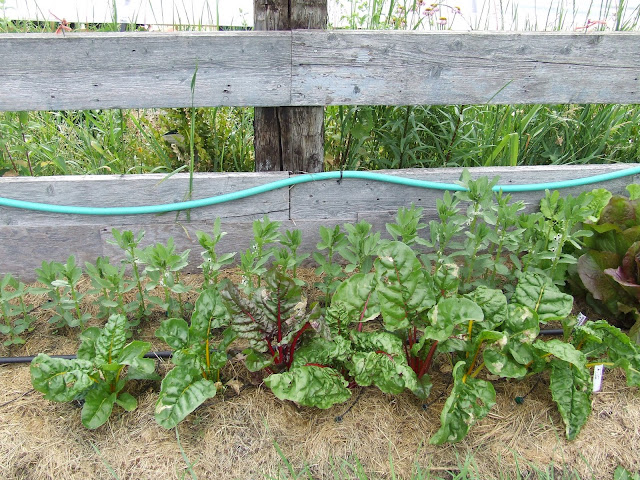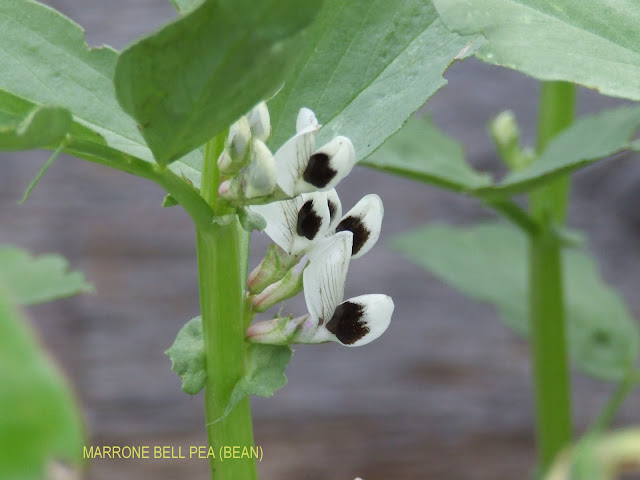|
|
Post by bunkie on May 26, 2010 12:28:44 GMT -5
graham, i transplanted these seedlings a couple weeks ago into the garden. they are staying short, but some have put on the most beautiful purple flowers, like in your pics. were these pole beans?
twelve seeds germinated out of all you sent. all have purple flowers except for two plants. they have the white and black normal ones.
will try and take pics soon. pouring rain for the next couple of days, so hard to get into the gardens.
|
|
|
|
Post by grunt on May 26, 2010 22:16:45 GMT -5
Bunkie: Favas will go to 3-4' tall, but need no support. If you look at these Marrone Bell peas hiding behind the chard  and picture them on steroids, you will have a fair idea of what regular favas look like for structure. Just to give you an idea of how unusual the color of Graham's fava's are, this is the usual fava coloration  |
|
|
|
Post by kathm on May 27, 2010 11:34:23 GMT -5
The standard crimson flowered broad bean - from which this is a selection - only gets to about 2 ft high for me - 2.5 on a good day! The pods are small too and only hold 3 or 4 seeds but they are the most amazing deep jade colour. I love them - they are by far my favourite broad bean to eat.
|
|
|
|
Post by atash on May 27, 2010 23:52:56 GMT -5
Are the crimson-flowered broad beans suitable, fully ripe, for using in salads or making falafel out of, as the Egyptians do? Or are they more of a broad skinny bean such as are usually eaten green?
The reason I'm asking is because I eat them the same way as the Egyptians do, fully ripe and dry before cooking. I want them small, fat, and with seed coats not too tough when fully ripe. I already have one but those red flowers look like a nice change of pace.
|
|
|
|
Post by robertb on May 28, 2010 3:34:19 GMT -5
I've only eaten them green, but if other BB's are used dried, then it would surely work with these.
|
|
|
|
Post by stevil on May 28, 2010 16:57:19 GMT -5
Are the crimson-flowered broad beans suitable, fully ripe, for using in salads or making falafel out of, as the Egyptians do? Or are they more of a broad skinny bean such as are usually eaten green? The reason I'm asking is because I eat them the same way as the Egyptians do, fully ripe and dry before cooking. I want them small, fat, and with seed coats not too tough when fully ripe. I already have one but those red flowers look like a nice change of pace. I also often make falafel with dried broad beans in the winter months and green in the summer - this should really be a staple in this part of the world as it's the only bean that can be grown outside successfully in our cold climate, but it's a rare vegetable here. I have many varieties including Crimson Flowered and I would say (from memory) that they are relatively thin skinned - I'm not too fussy about tough skins in falafel and just use all my varieties together, but I know others prefer their falafel smooth... Incidentally I found that the beans can be dried for seed whilst still green and they will germinate - an advantage in some years when not all beans will mature. Perhaps drying at this stage would make better falafel too? |
|
|
|
Post by robertb on May 28, 2010 18:13:30 GMT -5
Dunno about falafel, but I once dumped mulch on top of Crimson Flowered, and the green beans in the pods germinated.
|
|
|
|
Post by bunkie on Jun 1, 2010 11:06:36 GMT -5
thanks for the height info and pics dan. i'm also growing D’Aquadulce a Tres Longue Cosse Bean as well as graham's. these have the same flwoers as you posted, black and white. really quite attractive and different! i didn't know they needed no support.
attash, these purple flowered flava beans are a large size and kind of multi colored. not sure about taste, etc..., yet!
|
|
|
|
Post by wildseed57 on Jun 1, 2010 23:29:46 GMT -5
I've tried growing favas, first came the Ants then came the aphides and finally a black fungus. All my other ones like my yardlong, Limas and snap beans did great, but my favas were a wash outI do have a mind to grow some Runners, cutshorts and some greasies next year the runners have very pretty red flowers and the seeds can be quite colorful also, one that I like that is a runner type is called Purple Bears Paw, but that is another story.
George W.
|
|
|
|
Post by robertb on Jun 2, 2010 7:04:35 GMT -5
Varieties differ in aphid resistance. I had a disaster one yearwith Cosso Violetto, which was eaten alive by blackfly. Other varieties I've tried have done all right. Aquadulce Claudia is particularly tough, though it's not the best tasting. It might be worth giving it a try.
|
|
|
|
Post by cortona on Jun 2, 2010 7:51:56 GMT -5
i grow every year favabeans and usualy is aguadulce claudia that resist easily to aphyds...but if you want you can simply snap of the apex of the plants that are the favourite part for aphyds and probably you lost some flowers but wen the season go hotter is not so bad...the other ones mature faster!
|
|
|
|
Post by robertb on Jun 2, 2010 12:45:02 GMT -5
That's the traditional method, but I've never bothered. Either aphids smother the plant completely, or they seem to do no harm. If you do pick off the tips, they're worth eating.
|
|
|
|
Post by grunt on Jun 16, 2010 0:42:02 GMT -5
Graham: Just "unhid" your fava's in the garden ( a large curtain of weeds had their location completely obscured). Of the 8 or so plants that survived being repeatedly scratched up by the neighbor's chickens, half are purple flowered, half are regulation black and white. I'll try and get some pics of them tomorrow.
|
|
|
|
Post by kathm on Jun 16, 2010 4:27:32 GMT -5
They cross like the blaszes for me. I grow crimson at home so there's no chance of crossing. If you want to keep them pure, rogue out the white flowered ones. They cross over quite a large distance too - 20 ft or so. It's worse if you garden organically. If you've killed all your insects with sprays, you can probably plant them next to each other!
|
|
|
|
Post by Penny on Jun 16, 2010 5:44:15 GMT -5
Nice pics Dan  |
|